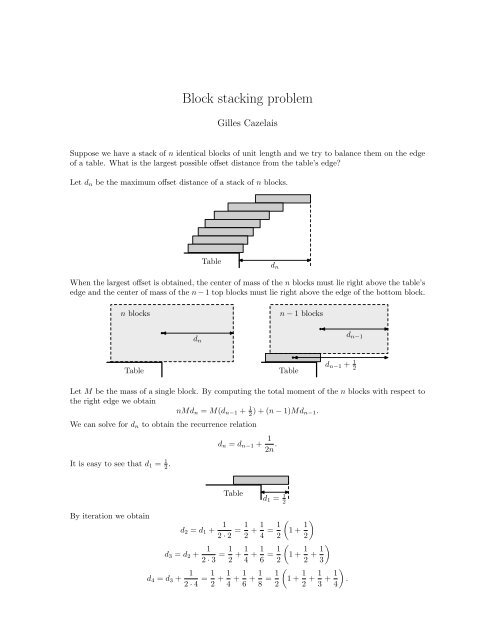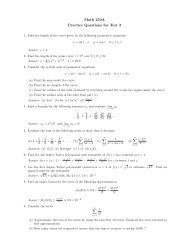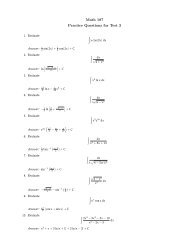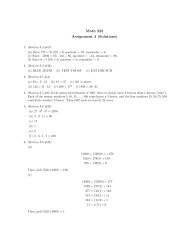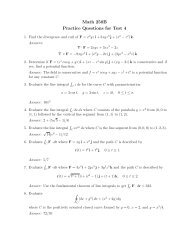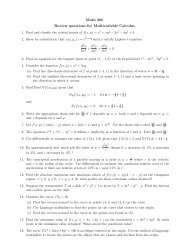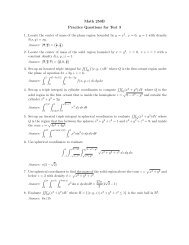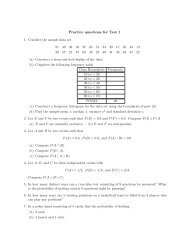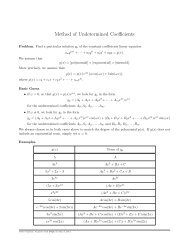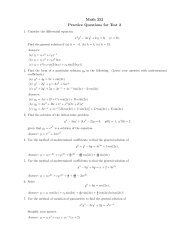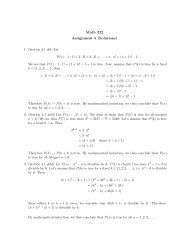Block stacking problem
Block stacking problem
Block stacking problem
You also want an ePaper? Increase the reach of your titles
YUMPU automatically turns print PDFs into web optimized ePapers that Google loves.
<strong>Block</strong> <strong>stacking</strong> <strong>problem</strong>Gilles CazelaisSuppose we have a stack of n identical blocks of unit length and we try to balance them on the edgeof a table. What is the largest possible offset distance from the table’s edge?Let d n be the maximum offset distance of a stack of n blocks.Tabled nWhen the largest offset is obtained, the center of mass of the n blocks must lie right above the table’sedge and the center of mass of the n − 1 top blocks must lie right above the edge of the bottom block.n blocksn − 1 blocksd nd n−1TableTabled n−1 + 1 2Let M be the mass of a single block. By computing the total moment of the n blocks with respect tothe right edge we obtainnMd n = M(d n−1 + 1 2 ) + (n − 1)Md n−1.We can solve for d n to obtain the recurrence relationIt is easy to see that d 1 = 1 2 .d n = d n−1 + 12n .Tabled 1 = 1 2By iteration we obtaind 2 = d 1 + 12 · 2 = 1 2 + 1 4 = 1 (1 + 1 )2 2d 3 = d 2 + 12 · 3 = 1 2 + 1 4 + 1 6 = 1 2d 4 = d 3 + 12 · 4 = 1 2 + 1 4 + 1 6 + 1 8 = 1 2(1 + 1 2 + 1 )3(1 + 1 2 + 1 3 + 1 ).4
We see that in general we have the following formula.d n = 1 2(1 + 1 2 + 1 3 + · · · + 1 )nThis result could be proved by mathematical induction.Since we know that the harmonic series1 + 1 2 + 1 3 + 1 4 + · · ·diverges to infinity, we get the surprising fact that the offset distance satisfieslim d n = ∞.n→∞This means that d n can become arbitrarily large provided that we choose n large enough.⋆ ⋆ ⋆How many blocks do we need so that the left edge of the top block extends beyond the edge of thetable? Sinced 3 = 1 (1 + 1 2 2 + 1 )= 11 and d 4 = 1 (1 + 1 3 122 2 + 1 3 + 1 )= 254 24we see that at least 4 blocks are needed.Tabled 3 < 1Tabled 4 > 1It is interesting to observe that sinced 52 = 1 2(1 + 1 2 + 1 3 + · · · + 1 )≈ 2.27,52if we use a deck of 52 cards instead of blocks, we can obtain an offset distance of about 2.27 times thelength of a card.Tabled 52 ≈ 2.27Gilles Cazelais. Typeset with LATEX on July 14, 2006.


